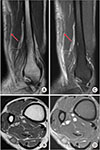Abstract
Nearly one third of the world's population have active or latent tuberculosis, resulting in 1.5 million deaths annually. Tuberculosis involving the peripheral nerve is difficult to detect. Sural nerve tuberculoma is an extremely rare case of tuberculous involvement of the peripheral nerve that has attracted the attention of physicians. This paper reports a patient with sural nerve tuberculoma. A 58-year-old female patient presented with a palpable mass on the posterolateral calf with progressive tingling sensation on the distal area. The patient had no history of trauma and it was unclear whether the patient had any contact with individuals with active tuberculosis. The histopathologic findings revealed a granuloma-like lesion with caseous necrosis that was compatible with tuberculoma.
Figures and Tables
 | Figure 2Fusiform dilatation of the sural nerve was seen. Low signal intensity on T1-weighted sagittal (arrow; A) and axial (B) images and intermediate to high signal intensity on T2-weighted sagittal (arrow; C) and axial (D) images were shown on magnetic resonance imaging. |
References
1. Stoeckli TC, Mackin GA, DeGroote MA. Lumbosacral plexopathy in a patient with pulmonary tuberculosis. Clin Infect Dis. 2000; 30:226–227. DOI: 10.1086/313622.

2. Song M, Sun X, Sun R, Liu T, Li G, Liu S, et al. Ulnar nerve tuberculoma: a case report and literature review. J Clin Neurosci. 2016; 32:130–133. DOI: 10.1016/j.jocn.2015.12.047.

3. Orrell RW, King RH, Bowler JV, Ginsberg L. Peripheral nerve granuloma in a patient with tuberculosis. J Neurol Neurosurg Psychiatry. 2002; 73:769–771. DOI: 10.1136/jnnp.73.6.769.

5. Nucci F, Mastronardi L, Artico M, Ferrante L, Acqui M. Tuberculoma of the ulnar nerve: case report. Neurosurgery. 1988; 22:906–907.

6. Hasa , Prakashvn SA. Tuberculoma of the ulnar nerve. A new clinical entity. J Int Coll Surg. 1964; 42:30–34.
7. Ramesh Chandra VV, Prasad BC, Varaprasad G. Ulnar nerve tuberculoma. J Neurosurg Pediatr. 2013; 11:100–102. DOI: 10.3171/2012.9.PEDS12172.

8. Chatterjee D, Lath K, Sharma RK, Das A. Ulnar nerve tuberculoma masquerading as a neurofibroma. Neurol India. 2015; 63:268–270. DOI: 10.4103/0028-3886.156305.





 PDF
PDF ePub
ePub Citation
Citation Print
Print






 XML Download
XML Download